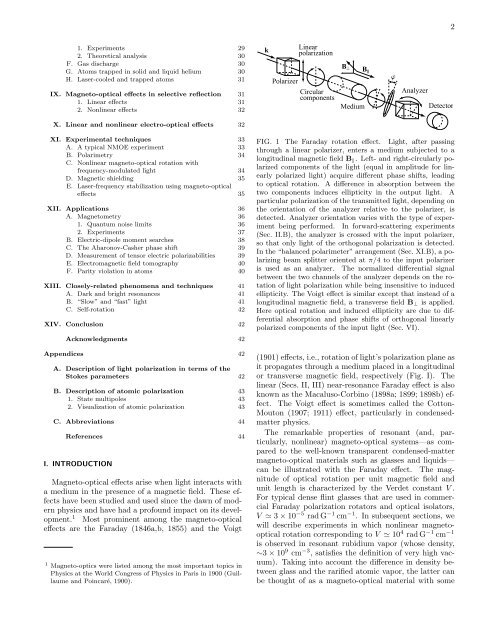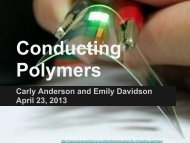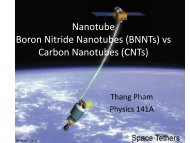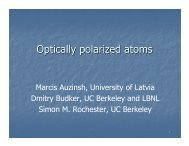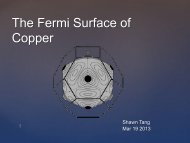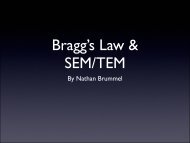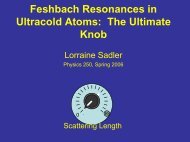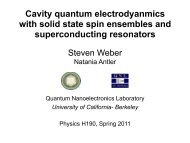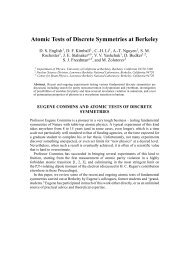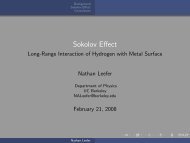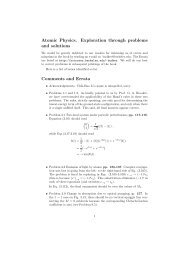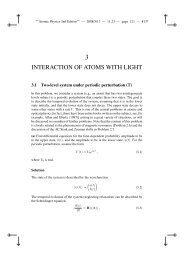Resonant nonlinear magneto-optical effects in atomsâ - The Budker ...
Resonant nonlinear magneto-optical effects in atomsâ - The Budker ...
Resonant nonlinear magneto-optical effects in atomsâ - The Budker ...
Create successful ePaper yourself
Turn your PDF publications into a flip-book with our unique Google optimized e-Paper software.
2<br />
1. Experiments 29<br />
2. <strong>The</strong>oretical analysis 30<br />
F. Gas discharge 30<br />
G. Atoms trapped <strong>in</strong> solid and liquid helium 30<br />
H. Laser-cooled and trapped atoms 31<br />
IX. Magneto-<strong>optical</strong> <strong>effects</strong> <strong>in</strong> selective reflection 31<br />
1. L<strong>in</strong>ear <strong>effects</strong> 31<br />
2. Nonl<strong>in</strong>ear <strong>effects</strong> 32<br />
k<br />
Polarizer<br />
L<strong>in</strong>ear<br />
polarization<br />
Circular<br />
components<br />
B ⊥ B||<br />
φ<br />
Medium<br />
Analyzer<br />
Detector<br />
X. L<strong>in</strong>ear and <strong>nonl<strong>in</strong>ear</strong> electro-<strong>optical</strong> <strong>effects</strong> 32<br />
XI. Experimental techniques 33<br />
A. A typical NMOE experiment 33<br />
B. Polarimetry 34<br />
C. Nonl<strong>in</strong>ear <strong>magneto</strong>-<strong>optical</strong> rotation with<br />
frequency-modulated light 34<br />
D. Magnetic shield<strong>in</strong>g 35<br />
E. Laser-frequency stabilization us<strong>in</strong>g <strong>magneto</strong>-<strong>optical</strong><br />
<strong>effects</strong> 35<br />
XII. Applications 36<br />
A. Magnetometry 36<br />
1. Quantum noise limits 36<br />
2. Experiments 37<br />
B. Electric-dipole moment searches 38<br />
C. <strong>The</strong> Aharonov-Casher phase shift 39<br />
D. Measurement of tensor electric polarizabilities 39<br />
E. Electromagnetic field tomography 40<br />
F. Parity violation <strong>in</strong> atoms 40<br />
XIII. Closely-related phenomena and techniques 41<br />
A. Dark and bright resonances 41<br />
B. “Slow” and “fast” light 41<br />
C. Self-rotation 42<br />
XIV. Conclusion 42<br />
Acknowledgments 42<br />
Appendices 42<br />
A. Description of light polarization <strong>in</strong> terms of the<br />
Stokes parameters 42<br />
B. Description of atomic polarization 43<br />
1. State multipoles 43<br />
2. Visualization of atomic polarization 43<br />
C. Abbreviations 44<br />
References 44<br />
I. INTRODUCTION<br />
Magneto-<strong>optical</strong> <strong>effects</strong> arise when light <strong>in</strong>teracts with<br />
a medium <strong>in</strong> the presence of a magnetic field. <strong>The</strong>se <strong>effects</strong><br />
have been studied and used s<strong>in</strong>ce the dawn of modern<br />
physics and have had a profound impact on its development.<br />
1 Most prom<strong>in</strong>ent among the <strong>magneto</strong>-<strong>optical</strong><br />
<strong>effects</strong> are the Faraday (1846a,b, 1855) and the Voigt<br />
1 Magneto-optics were listed among the most important topics <strong>in</strong><br />
Physics at the World Congress of Physics <strong>in</strong> Paris <strong>in</strong> 1900 (Guillaume<br />
and Po<strong>in</strong>caré, 1900).<br />
FIG. 1 <strong>The</strong> Faraday rotation effect. Light, after pass<strong>in</strong>g<br />
through a l<strong>in</strong>ear polarizer, enters a medium subjected to a<br />
longitud<strong>in</strong>al magnetic field B ‖ . Left- and right-circularly polarized<br />
components of the light (equal <strong>in</strong> amplitude for l<strong>in</strong>early<br />
polarized light) acquire different phase shifts, lead<strong>in</strong>g<br />
to <strong>optical</strong> rotation. A difference <strong>in</strong> absorption between the<br />
two components <strong>in</strong>duces ellipticity <strong>in</strong> the output light. A<br />
particular polarization of the transmitted light, depend<strong>in</strong>g on<br />
the orientation of the analyzer relative to the polarizer, is<br />
detected. Analyzer orientation varies with the type of experiment<br />
be<strong>in</strong>g performed. In forward-scatter<strong>in</strong>g experiments<br />
(Sec. II.B), the analyzer is crossed with the <strong>in</strong>put polarizer,<br />
so that only light of the orthogonal polarization is detected.<br />
In the “balanced polarimeter” arrangement (Sec. XI.B), a polariz<strong>in</strong>g<br />
beam splitter oriented at π/4 to the <strong>in</strong>put polarizer<br />
is used as an analyzer. <strong>The</strong> normalized differential signal<br />
between the two channels of the analyzer depends on the rotation<br />
of light polarization while be<strong>in</strong>g <strong>in</strong>sensitive to <strong>in</strong>duced<br />
ellipticity. <strong>The</strong> Voigt effect is similar except that <strong>in</strong>stead of a<br />
longitud<strong>in</strong>al magnetic field, a transverse field B ⊥ is applied.<br />
Here <strong>optical</strong> rotation and <strong>in</strong>duced ellipticity are due to differential<br />
absorption and phase shifts of orthogonal l<strong>in</strong>early<br />
polarized components of the <strong>in</strong>put light (Sec. VI).<br />
(1901) <strong>effects</strong>, i.e., rotation of light’s polarization plane as<br />
it propagates through a medium placed <strong>in</strong> a longitud<strong>in</strong>al<br />
or transverse magnetic field, respectively (Fig. I). <strong>The</strong><br />
l<strong>in</strong>ear (Secs. II, III) near-resonance Faraday effect is also<br />
known as the Macaluso-Corb<strong>in</strong>o (1898a; 1899; 1898b) effect.<br />
<strong>The</strong> Voigt effect is sometimes called the Cotton-<br />
Mouton (1907; 1911) effect, particularly <strong>in</strong> condensedmatter<br />
physics.<br />
<strong>The</strong> remarkable properties of resonant (and, particularly,<br />
<strong>nonl<strong>in</strong>ear</strong>) <strong>magneto</strong>-<strong>optical</strong> systems—as compared<br />
to the well-known transparent condensed-matter<br />
<strong>magneto</strong>-<strong>optical</strong> materials such as glasses and liquids—<br />
can be illustrated with the Faraday effect. <strong>The</strong> magnitude<br />
of <strong>optical</strong> rotation per unit magnetic field and<br />
unit length is characterized by the Verdet constant V .<br />
For typical dense fl<strong>in</strong>t glasses that are used <strong>in</strong> commercial<br />
Faraday polarization rotators and <strong>optical</strong> isolators,<br />
V ≃ 3 × 10 −5 rad G −1 cm −1 . In subsequent sections, we<br />
will describe experiments <strong>in</strong> which <strong>nonl<strong>in</strong>ear</strong> <strong>magneto</strong><strong>optical</strong><br />
rotation correspond<strong>in</strong>g to V ≃ 10 4 rad G −1 cm −1<br />
is observed <strong>in</strong> resonant rubidium vapor (whose density,<br />
∼3 × 10 9 cm −3 , satisfies the def<strong>in</strong>ition of very high vacuum).<br />
Tak<strong>in</strong>g <strong>in</strong>to account the difference <strong>in</strong> density between<br />
glass and the rarified atomic vapor, the latter can<br />
be thought of as a <strong>magneto</strong>-<strong>optical</strong> material with some


